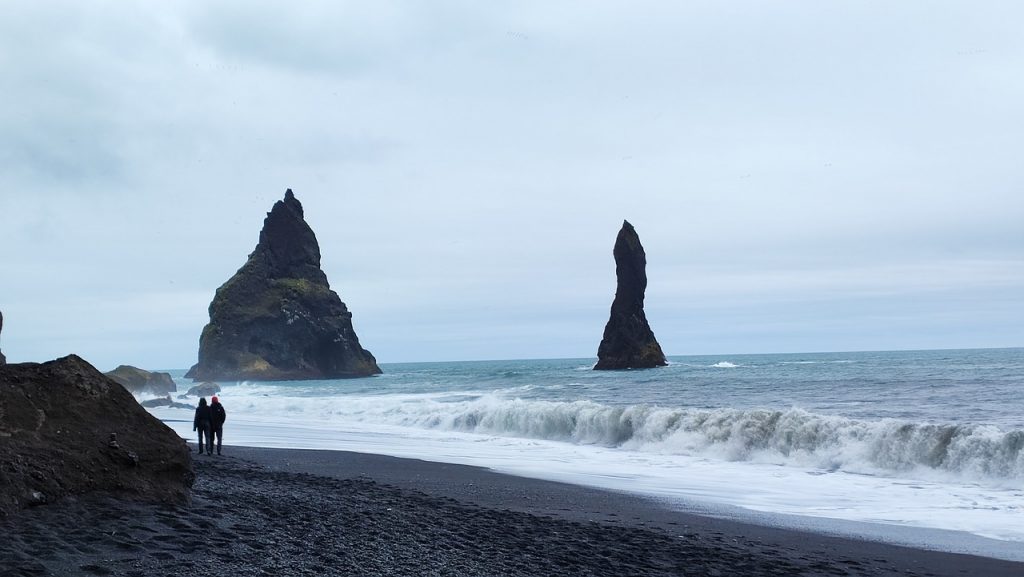
Iceland
Introduction
Iceland, known for its striking landscapes and unique natural phenomena, is often called a land of fire and ice. Among its many wonders is a captivating black sand beach in Iceland, which draws visitors from all over the globe. This guide delves into the mysterious beauty of these beaches and offers insights and tips for making the most of your visit.
The black sand beaches are a direct testament to Iceland’s volcanic origins. Each grain of black sand carries a history that spans hundreds of years. While these landscapes might appear otherworldly, they are integral to Iceland’s diverse ecosystem and cultural heritage.
The Allure of Iceland’s Black Sand Beaches
- Origins of the Black Sand: The black sand found on these enchanting beaches is primarily composed of basalt, a type of volcanic rock that has been shattered and ground down over centuries. Volcanic eruptions, particularly those from active volcanoes like Katla and Hekla, create this dark, granular sand, starkly contrasting Iceland’s icy landscapes.
- The Role of Volcanic Activity in Shaping the Landscape: Frequent volcanic activity makes Iceland’s landscape unique. The roaring interaction between flowing lava and the mighty North Atlantic waves results in these mesmerizing black sand beaches. Over time, what starts as rough volcanic rock is transformed into the smooth sandy stretches that attract tourists. This transformation process is continuous, with each volcanic eruption adding a new layer to the dynamic landscape.
- Famous Black Sand Beaches in Iceland: Iceland has several notable black sand beaches, each offering unique features and attractions. Among the most popular are Reynisfjara Beach, Vik Beach, and the Dyrhólaey Peninsula. These beaches provide breathtaking views and hold rich histories and geological significance.
Safety Tips for Visiting Black Sand Beaches
- Understanding the Dangers of Sneaker Waves: One critical safety concern when visiting Iceland’s black sand beaches is the presence of sneaker waves. These waves can appear unexpectedly and are powerful enough to sweep people off their feet. It is essential to keep a safe distance from the water’s edge, remain vigilant, and never turn your back on the ocean.
- Weather Precautions and Appropriate Clothing: Iceland’s weather is unpredictable, with strong winds and sudden rain showers common. Layering your clothing and wearing waterproof and windproof materials are essential for ensuring your comfort during your visit. Shoes must be durable and waterproof to handle the often slick and rough ground of the beaches.
- Using Local Resources Like Visitor Centers for Updates: Visitor centers are excellent for obtaining up-to-date information on weather conditions, tide schedules, and safety guidelines. The staff at these centers are usually local and can offer valuable insights and tips for safe travel. For additional information, the Safe Travel Iceland website offers practical safety tips tailored explicitly for travelers.
Top Black Sand Beaches to Explore
- Reynisfjara Beach: A Must-Visit Location: Reynisfjara Beach is perhaps the most famous of Iceland’s black sand beaches. Known for its dramatic cliffs and basalt sea stacks, it offers visitors unparalleled photo opportunities. The beach’s natural rock formations, such as the Reynisdrangar sea stacks, are both eerie and beautiful, creating an almost surreal atmosphere.
- Vik Beach: The Charm of the Southern Coast: Vik Beach, located near the small village of Vik í Mýrdal, is another captivating destination. Visitors can experience nature’s raw power while enjoying the black sands’ serene beauty. The beach offers fantastic views of the Reynisdrangar sea stacks and is a great place to unwind and enjoy sights. Nearby, the small town of Vik offers quaint cafes and shops where travelers can sample local delicacies and purchase souvenirs.
- Dyrhólaey Peninsula: Scenic Views and Wildlife: The Dyrhólaey Peninsula is not just a black sand beach but also a prime spot for viewing puffins and other seabirds. Its high cliffs provide an excellent vantage point that overlooks the vast stretch of black coastline, making it a must-visit for nature enthusiasts and photographers alike. The area also features a lighthouse that adds to the scenic charm, offering panoramic views of the surrounding landscape.
Activities to Enjoy on Black Sand Beaches
- Photography Tips for Capturing the Unique Landscape: The black sand beaches offer incredible opportunities for photography with their contrasting landscapes and dramatic backdrops. To capture the best shots, visit during the golden hours of sunrise or sunset when the lighting is soft and diffused. A tripod can be invaluable in windy conditions to ensure sharp images. Playing with different angles and perspectives can help showcase the unique textures and features of the black sand.
- Bird Watching Opportunities: Iceland’s black sand beaches are a haven for bird watchers. Species like puffins, Arctic terns, and skuas frequent these areas, especially near cliffs and rocky outcrops. Having binoculars with you can significantly improve your bird-watching experience, enabling you to watch these exciting birds in their natural environment without causing any disruption.
- Guided Tours and Local Experiences: Many local tour operators offer guided tours to the black sand beaches. These tours often include additional hiking, wildlife viewing, and storytelling sessions that delve into local legends and history. Booking a guided tour can enrich your understanding and appreciation of these unique landscapes and provide a safer and more informative experience.
Best Times to Visit
- Seasonal Highlights and Weather Considerations: While Iceland’s black sand beaches are beautiful year-round, each season offers unique charm. Summer provides long daylight hours and milder weather, making it ideal for exploration. Conversely, winter offers the chance to see the Northern Lights dancing over the black sands, creating a mesmerizing contrast. Spring and autumn bring their unique beauty, with blossoming flora in spring and vibrant autumn colors.
- Optimal Times for Photography and Wildlife Watching: The periods around sunrise and sunset, known as the “golden hours,” are perfect for photography because of the soft, diffused light that adds depth and dimension to the landscape. For wildlife watching, early morning and late afternoon are the best times when animals are most active. These times provide the best lighting conditions and increase your chances of observing wildlife.
- Planning Your Trip: Planning a visit to Iceland’s black sand beaches can vary depending on your monthly expectations. January to March has the most frigid weather and is the optimal time to witness the Northern Lights. April through June provide blossoming flora and milder weather, making it ideal for outdoor exploration. July and August are the warmest months and the height of the tourist season, offering the most extended daylight hours. September through December bring autumn colors and the return of the Northern Lights, offering a different kind of scenic beauty.
Preserving the Beauty of Black Sand Beaches
- Environmental Impact of Tourism and How to Minimize It: The influx of tourists to Iceland’s black sand beaches can significantly impact the environment. To minimize your footprint, stick to designated pathways and avoid disturbing natural habitats. Participating in eco-friendly tours and supporting local businesses that prioritize sustainability can also contribute positively to the region’s ecology.
- Leave No Trace Principles: Applying Leave-No-Trace principles is vital for preserving the beauty of these natural landscapes. This includes removing all trash, respecting wildlife, and not removing any natural features from the beaches. By following these principles, visitors can help ensure that the black sand beaches remain pristine for future generations.
- Supporting Local Conservation Efforts: Participating in or donating to local conservation efforts can help sustain the natural beauty of Iceland’s black sand beaches. Many organizations in Iceland are dedicated to preserving these unique ecosystems. Travelers can help by backing conservation projects, participating in beach clean-up events, and raising awareness about environmental sustainability.
Keep an eye for more latest news & updates on Wellknown Figure!






